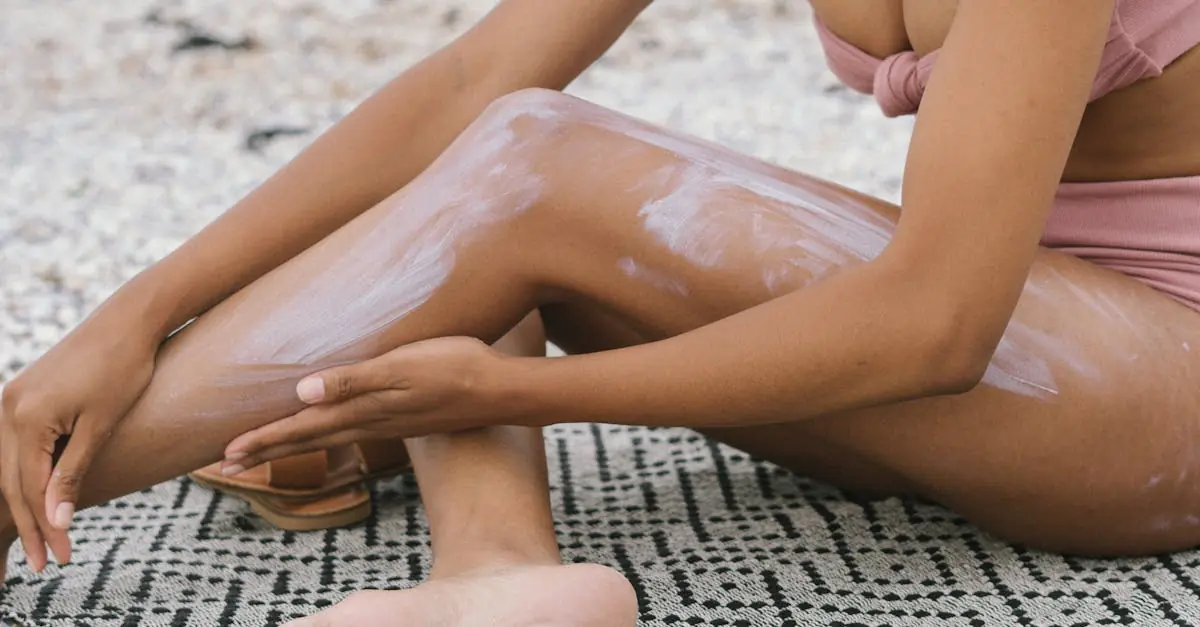Sunshine might make you feel all warm and fuzzy inside, but without proper protection, it can turn your skin into a crispy critter faster than you can say “ouch.” Applying sunscreen isn’t just a summer fling; it’s a year-round commitment that keeps your skin looking youthful and radiant. But when exactly should it make its grand entrance in your skincare routine?
Think of sunscreen as the cherry on top of your skincare sundae. Slathering it on at the wrong time is like putting the cherry on before the ice cream—messy and ineffective. Whether you’re a morning person or a night owl, knowing the right moment to apply sunscreen can be the difference between glowing skin and a sunburnt disaster. Let’s dive into the sunny side of skincare and uncover the secrets to perfect sunscreen application.
Table of Contents
ToggleUnderstanding Sunscreen and Its Importance
Sunscreen protects the skin from harmful ultraviolet (UV) rays. Daily application reduces the risk of skin cancer and prevents premature aging. Neglecting sunscreen exposes skin to sun damage, leading to dark spots and wrinkles.
Several factors emphasize sunscreen’s significance. UVA rays penetrate deep into the skin, causing long-term effects. UVB rays contribute to sunburn, making it essential to use broad-spectrum products. Sunscreen with an SPF of 30 or higher provides adequate protection for most skin types.
Selecting the right sunscreen product is crucial for efficacy. Chemical sunscreens absorb UV rays, while physical sunscreens reflect them. Many prefer formulations that blend seamlessly into their skincare routine, enhancing adherence to daily application.
Applying sunscreen should occur every morning. After cleansing and moisturizing, it forms a protective barrier. Experts recommend waiting at least 15 minutes post-application before sun exposure. Reapplication is vital every two hours, especially after swimming or sweating.
Choosing water-resistant formulas offers added security for longer activities outdoors. Sunscreen remains effective when applied correctly, ensuring maximum protection. Making this a consistent habit leads to healthier skin over time.
Awareness of expiration dates enhances product effectiveness. Sunscreens typically have a shelf life of three years. Using expired products can diminish their protective benefits.
Best Times to Apply Sunscreen
Applying sunscreen at the right times maximizes its protective benefits. Specific moments in daily routines play a vital role in maintaining skin health.
Morning Application
Morning application of sunscreen serves as the first line of defense against UV radiation. After cleansing and moisturizing, individuals should apply broad-spectrum sunscreen with an SPF of 30 or higher. Immediate application ensures skin remains protected throughout the day. Waiting at least 15 minutes before sun exposure enhances sunscreen effectiveness. Consistent morning use reduces the risk of sun damage and premature aging. Notably, this practice should occur year-round, even on cloudy days, to combat UVA rays.
Before Outdoor Activities
Before engaging in outdoor activities, timely application of sunscreen is essential for complete protection. Individuals must apply sunscreen at least 30 minutes before heading outside to allow for proper absorption. Reapplication every two hours during extended outdoor exposure helps maintain coverage against UV rays. Those participating in swimming or sports need to consider water-resistant formulas for added security. For maximum benefit, applying sunscreen after sweating or towel drying is crucial. Proper layering contributes to healthy, glowing skin and significantly lowers the incidence of sunburn.
How to Incorporate Sunscreen into Your Routine
Incorporating sunscreen into a skincare routine is essential for achieving and maintaining healthy skin. Prioritizing the right application method enhances its effectiveness.
Layering with Other Products
Start with a clean face. After cleansing, apply serums or moisturizers, allowing time for each product to absorb fully. Sunblock should be the final step in this routine. Apply sunscreen generously over the entire face and neck. Aim for about a nickel-sized amount. Consider using products with added hydration or antioxidants for additional skin benefits. Finish with makeup if desired. Remember to wait at least 15 minutes before sun exposure to ensure proper absorption.
Choosing the Right Type of Sunscreen
Select a broad-spectrum product with SPF 30 or higher for optimal protection. Chemical sunscreens absorb UV radiation, while physical sunscreens reflect it away. Choose based on skin type; oily skin often benefits from lightweight gel formulas, whereas dry skin may need creamier textures. Look for water-resistant options if swimming or sweating occurs. Check expiration dates to ensure effectiveness. Consider specific needs, such as additives for sensitive skin or additional skincare benefits.
Common Misconceptions About Sunscreen
Many people believe that sunscreen is only necessary on sunny days. However, UV rays can penetrate clouds, so protection is essential year-round. Another misconception involves SPF; higher numbers mean better protection, but broad-spectrum is just as crucial.
Some individuals think applying sunscreen once in the morning suffices for the entire day. Continuous exposure to UV rays requires reapplication every two hours, especially during outdoor activities. A common myth also exists around sunscreen thickness; applying more doesn’t always improve efficacy, but an adequate nickel-sized amount for the face ensures proper coverage.
Choosing any sunscreen may seem acceptable, yet not all products offer equal protection. Broad-spectrum options protect against both UVA and UVB rays, reducing the risk of skin damage. The assumption that darker skin doesn’t require sunscreen is misleading, as all skin types can suffer from sun damage.
People might assume that indoor environments provide sufficient UV protection. Yet, UVA rays can penetrate windows, so applying sunscreen even indoors is wise. Another frequent belief suggests sunscreen isn’t necessary during winter months. Snow can reflect UV rays, increasing exposure risks during ski trips or outdoor activities.
Lastly, some individuals think that sunscreen is optional if they wear makeup with SPF. Makeup doesn’t provide adequate coverage; a dedicated sunscreen application beneath makeup is crucial. Addressing these misconceptions can lead to better skin protection and overall health.
Incorporating sunscreen into a daily skincare routine is essential for maintaining healthy skin. By applying it consistently and correctly, individuals can significantly reduce the risk of sun damage and premature aging. It’s not just about sunny days; UV rays can affect the skin year-round.
Choosing the right product and applying it at the right time ensures maximum protection. With proper application techniques and regular reapplication, everyone can enjoy the benefits of radiant skin while safeguarding against harmful effects. Prioritizing sunscreen is a simple yet powerful step toward achieving long-lasting skin health.




